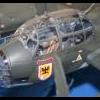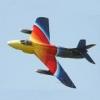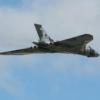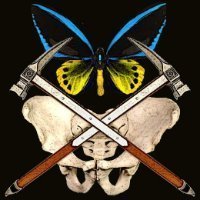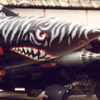Search the Community
Showing results for tags 'mpm'.
-
Having discarded the Airfix Sea Hawk I thought the MPM kit might be marginally better. It took a bit of prepping to get it reasonable, including blocking up the inside of the fuselage so you don't see through across the intakes. It's also very thick plastic with chunky joins between sprues and parts, but they file down ok. It needed quite a bit of nose weight, I just about squeezed in three small lead balls. Colours are EDSG upper and Humbrol 80 lower, both from spray cans. The tail bullet fairing is gloss black. Despite the photos there is an ejector seat, it just seems to sit really low in the cockpit! The decals included in the kit are pretty good, nice colours and well printed.
-
Special Hobby is to re-release the MPM 1/72nd Douglas Boston Mk.III Intruder kit - ref. 72398 Source: http://www.specialhobby.info/2018/11/sh72398-boston-mkiii-intruder-boxart.html Box art V.P.
-
Having read a couple of brief 'reviews' about the Airfix Sea Hawk on this forum I decided to sell both of mine and buy an MPM one instead! No doubt it's probably no better but there are limited options, and at least the decals look decent. I'll probably have to change the serial though as apparently WV863 was lost in a crash and I never build models of any aircraft lost. It just doesn't feel right to me somehow. I'll make this one with the playing card similar to the gate guard at Culdrose and FAA museum example, but representing an operational Sea Hawk. First question, anyone know of any visible differences between an FGA4 and FGA6 which with limited skill would be insurmountable?
-
My next build is going to be this nice kit from MPM. I didn't photograph the decals and PE, will fix that. I won't be building the kit with the decals supplied in the kit I will be doing a 77 Sqn RAAF Meteor "Darky Jones" flown by Sgt Ted Jones, which sadly crashed, ran out of petrol on landing. I have Red Roo decals and some rockets and bombs to go with the kit. They will also be photographed and added to the WIP. Some pics of the parts in the box. Resin parts. Thanks for stopping by for a look. Stephen
-
My 1st build for this GB will be MPM's 1/72 A-20G 'D-Day Havocs' boxing, this fit nicely with my Primary Theme for 1/72 Aircraft , WW2 US aircraft based in Essex, all 4 options in the kit , 2 from 410th BG , 2 from 416th BG were based in Essex between original deployment March 1944 and August/Sept 1944 when they moved to forward bases in Normandy. And for the Sprue shot complete with PE included in the kit (this will be fun !)
- 13 replies
-
- 10
-

-
Started this just after Christmas as a relaxing, no-stress build. I bought 3 different MPM boxing's of Hasegawa's Beaufighter when a seller on E-bay had them at a fairly cheap price, each one has several different marking options, Montex masks and PUR exhausts. The kit instructions cover ALL the decal options and are the same in each box, with colour Markings instructions with the variants in each boxing. This is from the RAAF box and covers Mk I, Mk VI and Mk21 in RAAF service. Each kit includes all parts to do early and late tail-planes, long and short intakes, tailwheels, AI aerials, etc. Also the Sperry Auto-Pilot housing. I chose to do an overall Aluminium finished Mk.21 and on doing a bit of research (unusual for me!) I discovered several Beaufighter's were stripped of their Overall Foliage Green finish. An interesting article here; http://www.adf-serials.com.au/newsletter/ADF Telegraph 2018 Autumn.pdf A8-196 is pictured if you scroll down the page. Of note was the fact that the instructions tell you to fit the long filter intakes and long (PUR) 'Hedgehog' type exhaust's, but the photo shows short intakes and the Mk I type short exhausts. I removed the framing from the later type rear canopy to try to represent the Australian style frameless type (not in the kit), it's not perfect but it'll do me. I left off the rear gun. Modified the starboard wing to the two gun type. Basically filling and re-scribe. Modified the wing tips to show the rearward 'Stem' type navigation light. Vallejo ModelAir Aluminium was used overall with a bit of AK Extreme to a couple of panels to add variation. A light wash into the panels while varnishing, doesn't show up much in the photo's but I'm still learning. The call out for the small Roundel's in the instruction's for the upper and lower wing I think is wrong, but I didn't spot this till this evening while putting this together! I think the photo shows the Larger style. I may change them later, but I might just leave them for another RAAF build (Overall Foliage Green) The kit went together well, hardly any filler used. I think the pilot's canopy looks a bit too tall and the whole fuselage is a bit 'pinched in', especially towards the rear. But, it looks the part I think. Last photo's show comparison with a High Planes kit I did last year. Criticism's and comment's welcome. Davey.
- 10 replies
-
- 27
-

-
Hi guys, Here is my build of the 1/48 P-63C King Cobra from MPM. This is already a started build, but not beyond the 25% mark. I started to build this I think 8 years ago, so it was a shelf queen. After the opening I saw why, the vac canopie is yellowed. But I will still build it as it is a great opportunity to do now. Here are the pictures. There is no box art, as I have lost the box long time ago and the kit is in another easier box to use. the started cockpit. the yellowed canopies The decals and the instructions As you can see there is also a decal sheet and instructions for a F version in the box. This also has a resin tail for it. Cheers,
- 20 replies
-
- 2
-

-
- P-63 KingCobra
- MPM
-
(and 1 more)
Tagged with:
-
It is my last finished model. This MPM model has bad fitting. It is not easy model. I used Mr Hobby colors. Cheers.
- 14 replies
-
- 36
-

-
This is my 1/72 MPM X-15A-2. This kit was a pleasure to build with very good fit and excellent decals. The only minus was the instructions which were kind of vague about colors and had a few of the decals mis-numbered. Construction only took 9 days from start to finish. I knew you would not be able to see much of the interior with those tiny window, so I took a couple of pictures before I buttoned it up Next up will be the Hasegawa S2F-1 Tracker kit. Enjoy
- 14 replies
-
- 24
-

-

-
I've got a bit stalled on my Fairey Long Range Monoplane and I've got an Airfix F-111 on the go in group builds, so I'm building this for some actual fun! It has been semi-started for a while now, and I painted up the cockpit when I was doing the old Airfix Blenheim. I was impressed by the etch instrument panels with celluloid backing. I tried an etch seatbelt for the pilot but the observer got a wine bottle foil and fuse wire harness instead. Not sure I will be able to tell the difference through the canopy... I kitted out the cockpit an extra seat and panel for the observer: The two transparent halves of the canopy worked well: ... as long as you check the width beforehand and add a wedge to the bottom of the fuselage: Thanks for looking, Adrian
- 33 replies
-
- 11
-

-
Hullo all. I was thinking about building a Merlin-engined Wellington II at some nebulous point in the future. I understand that the MPM kit has some shape issues (it certainly looks less like a Wellington to me in the photos I've seen of it) and I was wondering if anyone had tried to cross kit the MPM and Trumpeter kits to produce a Wellington II that was greater than the sum of its parts. Idle speculation is not only welcome, but encouraged.
- 9 replies
-
- 1
-

-
- 1/72 Wellington
- Tumpeter
-
(and 1 more)
Tagged with:
-

"World's Fastest Fireball" - The Ryan FR-4
TheRealMrEd posted a topic in Work in Progress - Aircraft
Hello all, Have just been puttering away on various old projects; not certain whether many would make a good WIP. However, there is one (actually of many) items that have been worrying my feeble mind for a number of years, trying to decide how to go about modeling them, the Ryan FR-4 Fireball, which is essentially an up-engined and modified FR-1 Fireball. These modifications were enough to make this version 100 mph faster than the original. I read somewhere on line that this aircraft held the world's speed record for a brief time. The visible modifications (or at least those of most concern to the modeler) consist of 1) removing the jet intakes from the leading edge of the wing 1) replacing said wing intakes with NACA intake ducts, and 3) lengthening the aircraft by some 4 inches. Judging from drawings and photos, the latter seems to consist of a longer tailpipe, so not too bad to manage. The best photo I could find of the FR-4 is this one, which shows the hardest areas of the needed mods: Not very exciting in terms of markings, is it? Note especially the raised lip around the NACA intakes; they are NOT flush with the outside of the aircraft! We shall attempt to duplicate them a little later on. For now, we begin with the basic MPM FR-1 Fireball kit in 1/72 scale (The ONE TRUE SCALE for all you slackers out there!) It looks like this: Note the nice brass PE -- probably the hardest part of the stock kit, other than a little flash here and there. BTW, don't even think of trying this mod with the Pegasus kit! It has so many problems that most wise men would probably bin it instead. I didn't, whence cometh the ire! I began by marking a straight line across the wings, showing where the protruding intakes need to be removed, by my trusty razor saw: I then sawed off the offending bits, as well as the front part of the wing that was molded onto the fuselage: Next the wheel wells were painted, and the leading edge of the wing was stuffed full of Milliput's finest, and the the wings were squeezed together, glued and clamped. The Milliput was then roughly shaped to a rough airfoil, pending more accurate sanding later. Those of you familiar with Milliput ill understand the need to get it shaped as well as possible before it hardens. It's not impossible to sand, but tough: And sanded: Also, be sure to clean any excess squeeze-out from the wheel wells! Well, that's all for now. Just a bit to peak your interest, assuming you are crazy enough to follow along. By the way, if a "grognard" (a soldier of the "Old Guard of Napoleon) is a very avid wargamer, what are we as modelers? Ed -
Hello everyone! I just saw this notice from Special Hobby that they're discontinuing all their Azur and MPM kit lines. They're now running a 50% off sale to close out their inventories of them. Anyone else here catch wind of this and what's behind it all? Are the moulds going to be taken into the Special Hobby line? Eliminated entirely and redone, eventually, with new tooling? Special Hobby Website Announcement - Plastic & Steel Online - Azur and MPM product lines are being discontinued now!
-
Hi, I've had this on the go for a while and finally got it finished today, it's the MPM kit of the PR10. Nothing wrong with the kit to cause a slow build just work getting in the way of good modelling time. The PR10 was a hybrid Meteor as it had an F8 fuselage but an F4 tail, with a long span wing and of course the camera nose. VS975 served only with 541 Squadron based in Germany from 1951 until it was scrapped in 1958. It was originally camouflaged and had the earlier part metal canopy. That makes 23 Meteors completed now. Thanks for looking. Steve
- 14 replies
-
- 27
-

-
Hi folks! Last year I built the wonderful Airfix Defiant as the famous N1801 "Coimbatore II", a nightfighter of 264 Squadron RAF, complete with lots of extras including Eduard photoetch, Barracuda wheels, Xtradecals, etc. You can see that build here. This left me with the quandary of what to do with my old MPM Defiant, built something like 9 years previously while I was still doing A-levels! I did take a photo of the model last year but it's gone astray so you'll have to make do with this one from 2008: As you can see, same scheme. I'll hope you'll agree it's not as good as the one from 2016! Anyway, having thrown all that AM at the Airfix kit left me with a lot of bits left over, including most of a decal sheet, a complete set of undercarriage doors, and two spare canopies. So I elected to strip down and repaint the MPM kit, and finish it as a Dunkirk/Battle of Britain machine - attempting to fix some of the worst inaccuracies of the MPM along the way. These chiefly involve the turret and canopy (both 2mm or so too high, the turret is also too large in diameter), and the undercarriage legs, which I'd already shortened by about 2mm back in 2008 shortly after the above photo was taken - but still looked too long. A quick test fit confirmed the Airfix closed canopy made the model look vastly better, and I combined this with sanding the turret down from the bottom. The undercarriage legs were quite badly damaged from being cobbled back together before, so I attached the Airfix door parts directly to the wing undersurface as a height guide and a solid anchor point, then having reattached the cleaned-up wheels I pieced back together and cut down the legs until the right amount of tyre showed underneath the bottom of the doors. This was another 2mm at least removed so the MPM legs are a grand total of 4-5mm too long. That's about a scale foot. I also had to scratchbuild some replacements for parts lost or too far gone to save, such as the rear undercarriage struts, radio masts etc. As usual it's brush-painted, although the Sky and the flat varnish come from a rattlecan. Decals were from Xtradecal stock, stencils I'd saved from the kit first time around (MPM helpfully provided two complete stencil sets, one in red and one in black!), and the fin flashes from the Airfix sheet. Scheme represents L7006 of 264 just after the Defiant's brief period of glory over Dunkirk. Hope you like it! I think this proves the the MPM kit can be made to look pretty like a Defiant without major surgery, although with the Airfix available it's almost certainly not worth the bother! Lastly a brief comparison shot. I think the MPM may still be touch plump around the centre fuselage, and it lacks some of the subtle shapes Airfix capture well, but the modifications make it look a lot better in my humble opinion
-
I've recently purchased an MPM Sea Vixen for a good price. However, I've started to wonder if the Cyber Hobby kit might have been a better buy as it seems to have a lot more aftermarket accessories. Does anyone know if either the Pavla or Quickboost nose-cones are a good fit for the MPM kit? Both were designed for the Cyber Hobby kit. Links below. Pavla nose. https://www.hannants.co.uk/product/PAVU72133 Quickboost nose. https://www.hannants.co.uk/product/QB72379 Has anyone used the Alley Cat resin parts before? The general upgrade kit looks good, but I'm not sure what I'm looking at in the the Radar Set; it looks like this set was designed to be displayed with the nose swung open? General upgrade https://www.hannants.co.uk/product/AC72022C Radar set https://www.hannants.co.uk/product/AC72023C Thanks for any help.
-
MPM is to rebox the Academy's 1/72nd Bell P-39/P-400 Airacobra kit with new decals. - ref. MPM72005 - Bell P39Q/N Airacobra "Russian Cobras" Source: http://www.aviationmegastore.com/bell-p39qn-airacobra-russian-cobras-mpm72005-mpm-8592016mpm72005-aircraft-scale-modelling/product/?action=prodinfo&art=140524 - ref. MPM72006 - Bell P-400/P-39D Airacobra "Cobras over the Pacific' Source: http://www.aviationmegastore.com/bell-p-400p-39d-airacobra-cobras-over-the-pacific-mpm72006-mpm-8592016mpm72006-aircraft-scale-modelling/product/?action=prodinfo&art=140525 - ref. MPM72007 - Bell P-400/P-39D Airacobra "Cobras over the New Guinea" Source: http://www.aviationmegastore.com/bell-p-400p-39d-airacobra-cobras-over-the-new-guinea--mpm72007-mpm-8592016mpm72007-aircraft-scale-modelling/product/?action=prodinfo&art=140526 V.P.
-
Hi mates, For my next project I've decided to build the rather unruly MPM/Xtrakit 1:72 Sea Vixen. After all of the bad reviews and general harassment this kit has received, one might be tempted to ask: Has Uncle Navy Bird lost the last tendrils of his sanity? Has he no other plastic to glue? Well, I can state rather emphatically why I'm building this kit: Because it is there. So, much like the earnest explorer planning his assault on Everest, we must first take stock of our raw materials (and in the case of this kit we do mean raw): In addition to the kit, the keen observer will notice a beautiful Model Alliance sheet of transfers, some Eduard painted photoetch, and a Pavla nose cone replacement, given away by its slightly darker shade of grey. The especially keen observer will notice the pinion tanks for the FAW.2 Sea Vixen, while the kit is clearly marked FAW.1. The boom extensions are required since I wish to replicate this rather colourful version, XS587, during her days as a ... I don't know, target tug perhaps (methinks that's what TT stands for)? Here is the decal sheet instructions for this scheme: Lovely, isn't she? Thanks to a very generous fellow Britmodeller who sent me the boom extensions, it looks like we have enough to start with. (I've already determined that the black stripes on the bottom of the fuselage are shown at the wrong angle on the artwork, so we'll correct that if we live long enough to get to the painting stage. More on that later.) I should also note that I have a brand new tube of putty, just waiting to be opened when I start assembly. It's a big tube (0.45kg), but it's a big job. Since the initial photography session, I've acquired the FAA Models resin correction kit which will help greatly on the hot end of this bird. Another interesting aspect of this kit is that includes its own resin aftermarket parts, including the two ejection seats. The odd part of this is that the bang seats are for dwarfs. What scale are these things? The pilot wouldn't be able to see over the instrument panel! Here we see the kit seats on the left, a pair of seats from PJ Productions in the center, and two seats left over from a CMR kit on the right. They're all supposed to be 1:72 scale Martin Baker Mark 4 seats (different versions), but only the CMR seats look the correct size. I also have the seats that came with the FAA set, and they're the same size as the PJ seats. Such decisions. Reminds me of the old line that when a man has one watch, he knows what time it is. When he has two, he's never quite sure. So that's my plan. You can help me by pointing out the known inaccuracies of the kit - no wait, that will take down Mike's servers. So don't do that, just talk me out of this!! Cheers, Bill
-
Hi all, I took my halfway built P-63 out of its cocoon and the vacform canopy has yellowed badly. There are no replacement canopies for the P-63, however, Squadron makes one for the P-39. Can I try adapting the Squadron canopy? Did these aircrafts differ significatively in this area? Thanks in advance, Bone
-
Saab AJ-37 Viggen 1:48 Special Hobby The Viggen was Sweden's Cold War fighter, which began service in the early 1970s with the AJ variant, which was primarily a ground attack aircraft that could also perform the fighter role if necessary. It was a tad shorter than the later JA, with a slightly different cockpit arrangement and a less powerful engine. Over a hundred were built, with roughly half of them converted to AJS standard at the end of the 90s with improved avionics and software. The last of these upgraded AJs were taken out of service in 2005. The Kit The initial Tarangus release of the JA-37 was a collaboration with MPM the parent company of Special Hobby, which has resulted in a split of the variants between MPM and Tarangus. I forget who is doing what at the moment, but can't wait for the two seaters! The initial release was well received for the most part, but like all model kits, some issues have been pointed out with varying degrees of hysteria, and as this is ostensibly the same moulding, many of those issues will apply to this kit. It is still a modern and mainly accurate tooling of an important and (IMHO) attractive aircraft, and should give any modeller plenty of enjoyment during the build, and it will of course look great in your cabinet. Inside the box it is almost the same plastic as the Tarangus edition, with only the gun-pack sprue missing, which also included the extension tube for the JA and the cockpit for that version. There are six sprues of mid-grey styrene, plus one of clear parts, a small Photo-Etch (PE) fret that is also pre-painted, and a decal sheet. The A4 instruction booklet is printed on thin glossy paper in full colour, which is rather helpful during construction, and the large size of the construction steps is welcome to this modeller and his failing eyesight. As construction is almost identical to that of the JA, which you can follow here I won't go over it all again, as aside from the lack of extension ring and the different cockpit tub and panel, it's near identical. I will however remind you that the detail in the main areas of interest is very good for injection moulded styrene, and the engine rear is superb. The cockpit is the recipient of the majority of the additional PE, which is decked out with a pre-painted instrument panel, side consoles and seatbelts, plus additional detail on the side of the seat, a pair of replacement rudder pedals and additional sidewall details. A trio of rear-view mirrors are also provided for the canopy when it is fitted later in the build. The gear bays are all well detailed, and as the inner main bay doors are usually closed when on the ground, no additional detail would be seen without the aid of a torch and the risk of a sore neck. The only items available in the box that you can hang from any of the pylons are a choice of centreline tank with either three or four fins, which fit to a stubby pylon just aft of a centreline intake fairing. It would have been nice to have some additional weapons included, but as the Viggen was often seen with just tankage, it's not a major thing. You might want to visit the inside rear of the instruction booklet before you go any further, as CMK (another MPM company) are bringing out a host of new updates to further improve on this already nicely appointed kit, as follows: 4310 M70 Rocket Pod x2 Q48219 Ejection Seat (Raketstol fpl37) Q48222 Thrust reverser petals Q48220 Air Brake Set Q48221 Wheels Maestro Models also do a substantial number of sets for the Viggen, but check that you're getting the ones tailored for the new kit before you pounce, or you might end up with parts for the old ESCI/Airfix kit. Markings The AJ was primarily seen wearing either bare metal finishes that was standard at the beginning of its career, or in the later disruptive splinter pattern we all know and love (and fear). There are some superb pictures of the variation in tone of the bare metal finish, and you'd go through extensive colours and masking tape doing it justice, but the finish would be well worth the effort. As to the splinter pattern, there are brave people that will tackle it themselves, and there has been a set of masks available for some years now from the US, but I'm sure some enterprising soul will produce a new set tailored to the new kit and more easily available in the near future. From the box you can build one of the following: 37062 "Gustav 62", F7 Wing, Satyenas, 1990s. Splinter scheme with red 62 on the tail. 37022 "Gustav 22", F7 Wing, Satenas 1973 – bare metal with squadron on fuselage and tail for an airshow in Germany. 37051 F15 Wing, Soderhamn 1978 – Splinter scheme with unpainted starboard intake in bare metal. The decals are well printed, with good register, colour density and sharpness, although there were a few tiny artefacts on my review copy, but these only really show up under magnification. There are extensive stencils on the sheet, all of which are legible, although I don't speak Swedish, so can't vouch for them being verbatim. Conclusion Another welcome kit of this superb Cold War Warrior, and with the addition of some PE to detail up the cockpit coupled with a reduction in price, it deserves to sell well. For the detail and accuracy minded, check the forums for information about the corrections needed to improve the kit further. Very highly recommended. Review sample courtesy of
-
Hi, Next "odd and old" German from current my production. After recent Dornier Wal I did next seaplane - Arado Ar 95 (on floats). It will be a small series - I started already work on next seaplanes: Ar 196, Do 22 and He 114 and one designed to be an aircraft carrier machine .- Fi 167... We will see how it will go. Frankly speaking I was not planning doing the German series now - I was planning do Douglas O38E (Haitanian from WWII) and O2D (Chinese), next Britts - Liberator GR Mk I and Sea Otter etc... - so they have to wait a while now. Perhaps I had to switch after making mostly Britts during last two years. Going back to Arado Ar-95. I have found that 3 of them were for sure in Spain from early 1937 - two on floats and one on wheels. They served in Legion Condor and then were given to Spain, AFAIK. On the other hand one can found in Wiki, that actually it was 6 of them there, but I have no confirmed it in other sources. They served till second half of fourties or something like that - so they survived Civil War. They were use for patrols in Meditteranean coasts of Spain based I think in Mallorca area. They were having numbers 64-1, 64-2 (float version) and the wheel version 64-3. MPM provided in model either markings for float machine 64-2 (an a German one) or for wheeled 64-3 and Chilean one. So I decided to make the thirs one - 64-1... Just not to do OOB. There are photos of this machine available, so it was not a big problem. With published painting schemes is no problem also - however I am only surprised by the lack of white crosses on wings. Arado 95 was produced in very limited numbers, but was used by Germany, Spain, Chile and Sweden (one escaped from Germany). Turkey as close to get some. In some sources it is said that even Poland in 1938 was interesting in buing the version on floats for sea-defense squadron based in Puck. The model is basicly a short-run, from late production (with injected canopy), one PE part (camshaft in engine - I did not used it making sctarch from plastic wire), resin rest of engine and cowling. There is some more scratch work added - the strutures on sidewalks on lower wings, masses (balances) of floaps and aerelions on upper wing, steps on front floats struts and the set of bombs. I made propeller rotable (as always). One remark for those who wants to build this model from MPM kit. Be careful with the struts. Some of them are made too long and one have to trim them. For example four struts supporting floats are of the same lenght on frames, wheres the front pair has to be sloped forward whereas the rear pair is perpendicular to float. So it will produce negative slope of whole machine. The same with pair of struts suporting the centre of upper wing. Fortunatelly drawing and photos are available in Net in reasonable amounts - you can easliy notice that bombs under wings have the Spanish machines but not the one which wscaped to Sweden etc... Sorry for this perhaps too long description - here she is: RLM-02 by Humbrol (No 240 - brush), riging by EZ, Vallejo matt coat Comments welcome Best regards and I wish especially Happy Easters to all BM members and spectators Jerzy-Wojtek
- 18 replies
-
- 17
-

-
- Arado Ar 95
- MPM
-
(and 1 more)
Tagged with:
-
Boston Mk. V/A-20J 1:72 Revell The A-20/DB-7 Havoc, better known to those with an interest in the Royal Air Force as the Boston, was a light bomber developed by the Douglas Aircraft Company of Long Beach, California. Designed to a US Air Force specification issued in 1937, the aircraft’s first customer was actually the French Air Force, who had been impressed by its performance whilst visiting the USA as part of a pre-war purchasing commission. Those aircraft not delivered to France by the time the armistice had been signed in 1940 were taken up by the RAF instead. The first squadron to be equipped with the Boston was 88 Squadron of Bomber Command. By the War’s end, no fewer than 24 squadrons had operated the Boston, either as a light bomber or night fighter. A handful of aircraft were converted to Havoc I Turbinlite standard, with a powerful searchlight in the nose, designed to illuminate enemy aircraft for accompanying night fighters. Unfortunately the huge searchlight made the Turbinlites an easy target and this particular chapter of the Boston’s history was not a successful one. The A-20 was also widely used by the USAAF and by the end of the war, almost 7,500 of the type had rolled off the production lines. Revell have been kind to those of us who choose to model in 1:72 scale over the last six weeks or so, as this kit follows hot on the heels of their Harrier GR Mk. 7/9 and Heinkel He 115. As with the aforementioned kits, this is also a re-release of a kit originally tooled by another manufacturer - this time from MPM of the Czech Republic. Nestled inside Revell’s familiar bright blue box are four sprues of grey plastic and a single sprue of clear plastic. Together they hold a total of 118 parts, which is pretty respectable for a kit of this size. There is no flash present anywhere and as far as I can see, there are no flaws in the plastic. Surface details are comprised of fine, engraved panel lines and there is a convincing stretched fabric effect on the rudder and horizontal tail. The overall impression is very favourable indeed. The cockpit is rather well-appointed for this kind of model. It is made up of a floor, seat, rudder pedals, two-part control column, instrument panel, sidewalls and bulkheads. A decal is provided for the instrument panel, but it isn’t really needed as the instruments are picked out with fine, raised details on the plastic parts. The bomb aimer/observer position is just as good and includes a very nice bomb sight. The crew positions are completed by the mid-upper turret, which is a little more basic than the other positions, but still good enough to pass muster. Once the fuselage halves have been joined together, the wings and horizontal stabilisers can be assembled and fixed to the fuselage. The parts have location tabs and slots to help ensure a positive fit. The prominent cowlings, under which hide the large Double-Cyclone engines, each have to be fitted with nine cooling vents. Fortunately Revell’s instructions are very clear in this regard, so you shouldn’t have any problems. The engines themselves are made up of three parts – two rows of seven cylinders and the reduction gearing. They are nicely detailed and should look good once assembled. The undercarriage looks well detailed, but frighteningly complex. Each of the main gear legs is made up of no fewer than six parts, plus the wheels themselves. I would recommend taking great care over these stages in the instructions, lest you end up with a wonky aeroplane when you come to rest it on its tyres. The main gear legs actually fit directly to the wings, and it is possible to fit the rear engine nacelles over these parts afterwards. This should make things a little less frustrating as you will be able to place the parts precisely rather than having to stuff them inside a cramped undercarriage bay. The remainder of the build is concerned with the addition of the transparent parts and the remaining fine details. These include the radio antenna and DF loop as well as the .303 Browning machine guns. The guns are very nicely recreated and the cooling sleeves in particular are convincingly detailed. The transparent parts are thin and clear and shouldn’t present any problems, although I have not been able to check to see how well they fit at this point in time. Two options are provided for on the decal sheet: Douglas Boston Mk. V, No, 13 Squadron, 232 Wing, Royal Air Force, Italy 1944; and Douglas A-20J Havoc, 646th Bomb Squadron, 410th Bomb Group, 9th Air Force, USAAF, Gosfield, England, June 1944. Both aircraft are finished in Olive Drab over Neutral Grey. The decals are nocely printed but they look a little matt. Conclusion As this is the only modern tooling of the Boston in 1:72 scale, it’s fairly easy to recommend it to modellers interested in adding the type to their collection. It looks very good indeed on the sprue, although opinion seems to be divided on how easy it is to build. Some people have reported fit issues whilst others have stated that the kit is a breeze to build. Nevertheless, it is still the best Boston out there and can be firmly recommended. Revell model kits are available from all good toy and model retailers. For further information visit
-
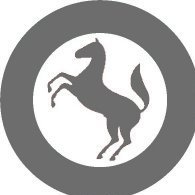
Airfix Gloster Meteor F.8 9 Sqn
charlie_c67 posted a topic in Gloster Meteor Single Type Group Build
So, just a little place marker for my entry to this build. And a pic of the set being used :-) -
Tim "thePlasticSurgeon" suggested this kit as a good start when I visited the Jet Age Museum a while ago: An excerpt from the squadron’s records of the 4th August 1944 states “F/O D “Dixie” Dean took off from Manston at 1545 to patrol inland area under Kingsley II (Biggin Hill) Control. At 1616 hours a Diver was sighted at 1000 ft near Tonbridge on course of 330°, at speed of 365 IAS. Dean dived down from 4500 ft at speed of 450 mph, and attacked from dead astern; his 4 x 20mm cannons failed to fire owing to a technical trouble now being investigated, so flying level alongside the bomb, Dean manoeuvred his wing tip a few inches under the wing of the flying bomb and by pulling upwards sharply he sent the bomb diving to earth four miles South of Tunbridge." From the IWM website wing tip from Gloster Meteor aircraft serial number EE 216. © IWM (EPH 4609)IWM Non Commercial Licence Gloster Meteor Is of No 616 Squadron at Manston, 4 January 1945. The Allies' first operational turbo-jet aircraft, the Meteor entered service with No 616 in July 1944, being employed against the V-1s. Despite its revolutionary power-plant (two 1,700lb-thrust Rolls-Royce Welland engines), the Meteor I's top speed of 410mph was below that of the Tempest or Spitfire XIV. ROYAL AIR FORCE 1939-1945: FIGHTER COMMAND. © IWM (CL 2925)IWM Non Commercial Licence
- 100 replies
-
- 6
-

-
MPM will release 1/72 P-47M-1 European Theatre sprues from Academy new box and decals ref MPM 72004 Like older P-38 this kit is from MPM s.r.o (MPMSHOP , MPM Prodejny). This is local retailer and official Czech distributor of Hasegawa, Airfix, Academy etc. http://www.mpmshop.cz/ https://www.facebook.com/pages/MPM-prodejny/556674341063606?fref=photo ( Not to be confused with MPM Productions (aka Special Hobby) kits producer. Company was divided long time ago and they still use almost same "MPM" logo for some products. Produce company using http://www.mpmkits.com/, http://www.cmkkits.com/ and http://www.aeromodel.eu/ websites. )
- 14 replies
-
- thunderbolt
- mpm
-
(and 6 more)
Tagged with:





